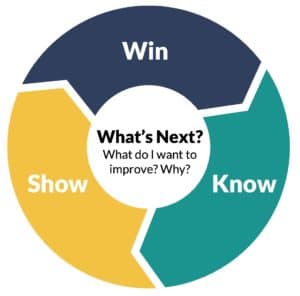10X Your Results Using the Progress Principle
Some coaches are masters of the halftime adjustment. Love him or hate him, when Bill Belichick’s Patriots are losing or tied at halftime they come back to win those games 47% of the time. The rest of the NFL? Only 26% of the time. Future Hall of Fame NBA coach Gregg Popovich is unparalleled against the spread in the second half of ball games. Sure, it helps to have future hall of fame talent on your team to pull off all these second half miracles, but these coaches and their staffs are just better than their peers at turning around a team at halftime.
How are you at “halftime” adjustments? Since we just began the second half of 2019 (can you believe it?) this is a good time to reflect back on your goals for the the year. It’s also a great time to talk to your team about their goals for the year, and see if you can help them make any halftime adjustments.
If you’re like me you’ve been a little up and down in the first half. What kind of adjustments can we make to win the second half of the year? Here are some tips I’m going to use that I hope will help you and your teammates.
Progress Principle
The Progress Principle helps you stay motivated (and grow your motivation) to achieve your goals. It is based on the idea that we are most motivated on days where we make progress (no matter how small) toward our destination. We are least motivated (and at highest risk of giving up on our goals) on days when we make no progress or feel like we’ve taken a step back. The Progress Principle by Teresa Amabile Steven Kramer explains the compelling research around how this principle works.
The core premise is this: to maximize the chances to stay motivated to reach our goals we should optimize our days for progress. And the best way to optimize for progress is to pick the smallest possible step we can take toward our goal. If you set the bar too high you increase the chance that you won’t make progress that day. No progress, no motivation.
When you break down goals to their smallest actionable step you optimize for progress, making it more likely that you’ll take the next small step (and increase your motivation to take the steps after that). Then it’s one foot in front of the other. You can massively increase your output by optimizing your days to take one small step in the right direction.
Win-Know-Show
 In our Approachable Leadership Workshop one of the things we teach leaders is to ask their team the question “What’s Next?” The assumption behind this question is the progress principle, and when we teach it we also teach the simple “Win-Know-Show” model.
In our Approachable Leadership Workshop one of the things we teach leaders is to ask their team the question “What’s Next?” The assumption behind this question is the progress principle, and when we teach it we also teach the simple “Win-Know-Show” model.
“Win” simply means identify the next small win – the smallest win you can think of. It should almost seem silly. Think about any big changes you have ever wanted to make in your life. Maybe you wanted to lose 25 pounds. Or start a business or earn a big promotion. Write a book or movie. Or master a skill or hobby. These are big goals, not small wins.
The thought of accomplishing these big goals can be exciting at first, even though the thought of making it happen can be daunting and even scary. The bigger the goal the more difficult it can be to figure out how to tackle it.
The Secret to Achieving Your Goals
But you can break down goals into smaller components to make them more achievable. You can take a step towards losing weight by walking 100 steps after each meal or adding a salad with each meal. To earn that promotion maybe asking if your coworkers if they need help on anything or asking your supervisor what you could learn to provide more value. To master that skill you can start by dedicating 5 minutes a day to reading or practicing. These goals are much more concrete, easier to start, and more likely to build habits that lead to long-term change.
And remember, any effort expended towards that goal is progress in the right direction. The time and energy you spend on these little changes will put you on the right track. If you are not taking these little steps, then you are likely spinning your wheels trying to figure out how to accomplish your big goal. Taking little steps puts you closer to your goal than thinking about the big goal.
Applying Win-Know-Show to Your Halftime Adjustments
How can you put the power of Win-Know-Show to work in your halftime adjustments? Look at what you want to accomplish in the second half of this year. Are there any big goals you had on your list in January that are stalled? Take one or two of those and break them down using the Win-Know-Show model.
1. WIN: What is the smallest next step you can take toward that bigger goal?
By the way, habit stacking is a great way to make these little adjustments. Earlier this year I had a plantar fasciitis flare-up. I visited a physical therapist who told me I needed to stretch more. Duh. But then he wisely said, “but if you’re like 99% of the people I see you’re not going to do that, right?” Well, now I was listening. “Yeah, I might do it for a few days but no way I’m going to start consistently stretching,” I told him.
He then said, “you brush your teeth, right?” Uh, yeah. “Then put this piece of foam right in front of the sink where you brush your teeth,” he said as he handed over a half-circle foam roller. “Put your toes on this and lean into your sink while you brush. You’ll get 8 minutes of stretching a day.” And like that, I started a “stretching program” that I’ve kept up with daily months later. This worked because the step was really small (stand on this while you brush your teeth) and connected to a habit I already had (brushing).
2. KNOW: How will you know you’re making progress?
In today’s world where you can measure almost anything with your watch, phone or wearable device, there are tons of ways to track progress. Here I’d suggest blunt versus precision instruments. Instead of getting paralyzed with data, just focus on “right direction, wrong direction” measurements. Like using the Seinfeld Strategy to stop procrastination.
3. SHOW: Who will you show (and when will you show) that you’ve accomplished the win?
Last you need to find someone to share (and maybe even celebrate) your latest win. This person can help hold you accountable and help you celebrate your small victory. Ideally they’ll then help you start the cycle over by identifying another small win.
That’s it. Just rinse, lather, and repeat.
Applying Win-Know-Show to Your Team
This model is a great way to coach your teammates on their own halftime adjustments. An approachable leader wants to constantly be checking in on the progress of their team. But most “performance appraisals” are backward-focused, demotivating, and often too rare or late to make any difference. Instead, ask the question, “What’s Next?” and start looking ahead to next small wins. These conversations are way more motivating and much more likely to achieve actual results.
If you put the power of incremental progress to work for your team, your combined results can’t help but improve. We’ve included a copy of the Win-Know-Show discussion guide in our Retention Toolkit. Maybe you won’t create the next sports dynasty, but your halftime adjustments will definitely get results.
Do you have a “What’s Next” that you’re working on? Add your “Win-Know-Show” to the comments, and we can help you with your halftime adjustment!










